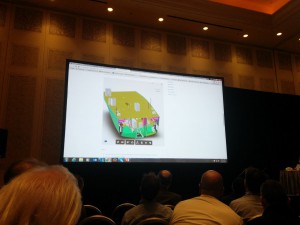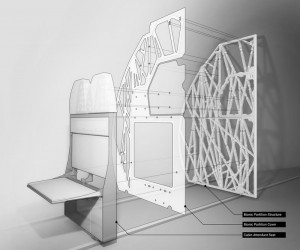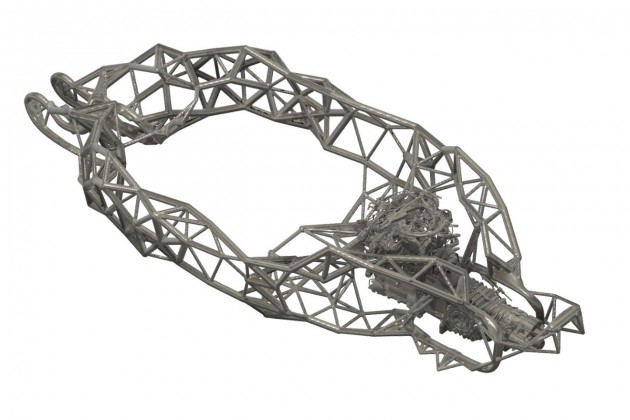ADN – (Autodesk Developer Network)

The conference started with ADN DevDays. As one of the biggest (and most important ) ADN developer it is important for SSI to participate in this day to see what is coming down the pipe. I have to say that this year I was blown away with the platform Autodesk has created and the work the ADN team has done to build a community. I forget what I can and cannot say publicly so I will not get into the details. All I can say is that it looks like it will be an amazing next few years. I was honored that Jim Quanci (Senior Director, Autodesk Developer Network) showed my blog on the big screen at AU. This is the post he showed.
Augmented Reality
I really wanted to see the Microsoft HoloLens with Fusion 360 but the showing was full. This takes visualization/augmented reality and collaboration to a whole different level. I have only seen videos of HoloLen and really want to see how immersive the experience will be.
Another technology I came across which was really cool was from Google called Project Tango. I was totally amazed that I had no idea of its existence until AU and then was blown away about the technology and its real world application. The idea of Project Tango is that it uses a tablet-like device (with additional built-in sensors) to detect the world around you in 3D. It then lets you use that information to either create an augmented reality such as inserting a 3D object into the scene or you can save the scanned data to an obj file to be used by other applications and workflows. It did remind me a little bit of what dotProduct has; however, Project Tango is more of a platform than a final product solution.
September 27, 2013
An interview with Jon Wells – Part 2
This is the second part of the two-part interview with Morgan Motor Company’s Head of Design, Jon Wells. Here’s the first part, in case you missed it. How long has Morgan been using Autodesk software? I introduced Autodesk software to the company when I joined. I was the link between the aesthetic designer that had just joined the company – who was very visual-based – and the engineering team. With my technical background and understanding of 3D and surfacing, I was able to understand both the aesthetics and how that would interpret into an actual, physical component. And to…
Read more →
Отец БИМ — создатель SONATA или RADAR CH?
Если формат для (open) BIM моделирования был один — STEP/IFC, то в отношении первой настоящей программы для BIM (3D) моделирования всё намного сложнее. Это RUCAPS, Sonata, Reflex и RADAR CH. Но какая программа стала первой по-настоящему применяться для BIM моделирования?
Программа RUCAPS стала первой программой, которая в комплексе с единой рабочей станцией использовалась для реального проектирования зданий. Разработанная английскими инженерами Dr John Davison и John Watts, которые работали над проектом для Университета Эр-Рияда, RUCAPS стала одним из прообразов и ориентиров для многих последующих программ в BIM моделировании. В RUCAPS впервые была заложена концепция строительства по фазам, что очень помогло при возведении третьего терминала аэропорта Хитроу в Лондоне. Эти и ещё более ранние наработки, возможно, позже легли в основу программ, ставших настоящими прообразами уже современных программ — Sonata и Radar CH. Но что же появилось раньше: Sonata от Jonathan Ingram или Radar CH от Bojár Gábor и Ulrich Zimmer? Кого можно считать отцом BIM?
Во многих источниках на просторах интернета фигурирует, что ArchiCAD (первая версия называлась RADAR CH) в 1984 году стала первым программным обеспечением BIM, доступным на персональном компьютере. Сторонние специалисты отмечали, что в 80-х советские инженеры были впереди своих западных коллег в темах, которые касались машинной графики и геометрического моделирования. Поскольку экспорт в коммунистические страны был ограничен, программисты из Советского Союза привыкли работать на очень маленьких и простых компьютерах. Это означало, что у них был опыт создания относительно сложного программного обеспечения, которое могло работать на относительно простом оборудовании.
Dr Jonathan Ingram, в свою очередь, утверждает, что первым BIM программным обеспечением является написанная им программа Sonata, опубликованная в 1985 году. В подтверждение своих слов он ссылается (в личной переписке со мной, к сожалению, не могу проверить их подлинность) на открытые письма от создателя ArchiCAD, в которых Gabor Bojar признается, что на создание RADAR CH также повлияла Sonatа.
На просторах интернета также можно найти изображение (справа) от Graphisoft (RadarCH), которое считается доказательством первой визуализации в 1984 году.
В общем, в этой истории больше вопросов, чем ответов. К первой визуализации Radar CH есть вопрос, так как компьютеры Mac с поддержкой цвета появились только в 1987 году. Но почему Steve Jobs сделал ставку на венгерско-советский стартап, находящийся за железным занавесом и не стал договариваться с близкими стартапами, которые разрабатывали ПО в силиконовой долине (скорее всего, Gabor Bojar нелегально смог импортировать несколько Mac компьютеров в Венгрию и переписал свой софт с медленных советских компьютеров на быстрый Mac). А на вопрос, откуда Gabor Bojar получил доступ к наработкам Sonata, Jonathan Ingram предпочёл не отвечать в письменной форме.
Словом, запутанная история, в которой только Интерпол, ЦРУ и КГБ может помочь нам разобраться: кто, когда и у кого взял идеи. Или всё-таки эти две программы имели общую теоретическую основу.
Предположу, что обе — ПО Radar CH и Sonata — начали с общей теоретической базы (RUCAPS или его подобие). Но при этом венгерская Radar CH была только трехмерной системой, с ограниченными параметрическими компонентами, в то время как у Sonata уже появились некоторые преимущества в создании рабочих чертежей, например, планов высот. В итоге, после публикации обеих систем, эти программы, возможно, позже черпали вдохновение друг у друга. Как сказал Gabor Bojar: «Конкуренты всегда учатся и влияют друг на друга, это стандартная и честная деловая практика».
B это же самое время на другом, “более успешном”, материке начинается новая эра CAD и MCAD ПО, которую открыла компания PTC (Nasdaq: PMTC) cо своим инновационным продуктом Pro/ENGINEER.
July 31, 2009
Interviews with ADN members
Back at last year’s AU, my manager (Jim Quanci) and I were asked to interview members of the Autodesk Developer Network for the AutoCAD Exchange site. Here are a couple of those interviews that I came across on YouTube, both with long-time Autodesk development partners. First up is an interview with Rob Smith from SprinkCAD. And now Jim interviews Christian Dubuc from 20-20 Technologies. Overall I do prefer preparing written interviews: with a video interview I find it hard to listen, think and then talk, especially when the interviews are unscripted and shot in one take, as these were….
Read more →
Cloud
It is not surprising that Cloud was a theme at Autodesk University yet it was not as much front and center. I think there are many reasons for this but the main reason is because most of us do not need to be convinced that cloud is going to change what/how we do things. We know it will and for the most part has already.
I know the shipbuilding industry mainly thinks that the cloud will never work for our industry because we are special and different. Ironically the same people in shipbuilding who say this are the first people to say that the shipbuilding industry is always lagging behind other industries. Maybe they are related :).
To get back to AU there were a lot of good solutions and material revolving around the cloud. The most interesting presentation was by Richard Noriega – Mechanical Engineer, Vacco Industriesand Martin Gasevski – Autodesk, Inc. The main reason it was interesting is because Vacco is using Autodesk PLM 360 (a cloud based PLM) on projects that require ITAR. They are not storing any drawings or technical packages on Autodesk PLM 360; however, they were doing their change management, NPD, RFQ and integrating into several other systems they use.
It was good to see this hybrid approach on an ITAR project as most people think cloud is all or nothing. I still need to find more information on how they got approval for some data (eg. BOM) to be on the cloud. The key thing to note though is that it is possible.
During this conference I meet with several Autodesk product teams. This year I met with the A360 product team for the very first time. I shared some experiences I have had over the last while. The interesting thing was to hear how the Autodesk 360 products are starting to align to use a similar backbone/foundation. I really do believe that with their current direction we are going to be having some very compelling workflows for those of us who are in the shipbuilding industry.
Generative Design
Another emerging trend discussed was Generative Design which is a design method where the output is generated by a set of rules or an Algorithm. This has been talked about for a while and was a key topic in Jeff Kowalski Autodesk’s CTO keynote. I find Generative Design to be very interesting and very difficult to get my head around how you define the constraints. I know it sounds easy because we define constraint all the time in our projects. The thing is, the constraints in generative design are different and require a new way of thinking and defining constraints.
 |
 |
A real world example of generative design could be in Airbus’s planes in the New Year. This “bionic partition” was generated using generative design and 3D printing. I was able to see this up close and personal and I have to say I am still baffled that this design is orders of magnitude better than what any human could design. It is estimated this will save Airbus 465, 000 metric tons of CO2 every year. That calculates to about the same emissions as 96,000 passenger cars or a Suexmax tanker running for 1 hr :).
An interesting point Jeff mentioned is to also use the real world to provide information into this generative model as input. This will allow it to then continue to optimize the design on its input. An example of this was Project Primordial which designed a car chassis. They drove a human designed “car” around a track monitoring as much data as possible. They then defined some constraints and input all the data collected during the test run into Dreamcatcher (Autodesk’s generative design software). The result is a generative designed car chassis which looks different from our current standards but is supposedly superior in all areas where it needs to be (strength, weight, agility, etc.).

October 03, 2008
An interview with John Walker — Part 4
This is the fourth and final part of the series documenting my recent interview with John Walker. Where the first three parts looked at the early history of the company, the architectural evolution of AutoCAD and its APIs and Autodesk’s strategy and eco-system, this part takes a look at past and future business opportunities for the company. I have not linked to terms previously linked to in the first part of the series, which should also be referred to for typographical conventions, if they’re not clear. Part 1 — Autodesk’s early history Part 2 — AutoCAD’s architecture & APIs…
Read more →
February 16, 2015
An interview with Mike Aldred about the Dyson 360 Eye
Back in September, Dyson announced their long-awaited entry into the robo-vacuum market with the Dyson 360 Eye. I was delighted to see an old friend of mine, Mike Aldred, in one of the launch videos: Mike and I were undergraduates at the University of Kent at Canterbury (UKC) together, back in the ‘90s. I was studying European Computer Science (which meant I was on a 4-year degree programme with the 3rd year spent studying Computer Science in Paris) while Mike was studying Computer Systems Engineering. I vaguely recall having common classes together with Mike, although as Mike started at…
Read more →

































